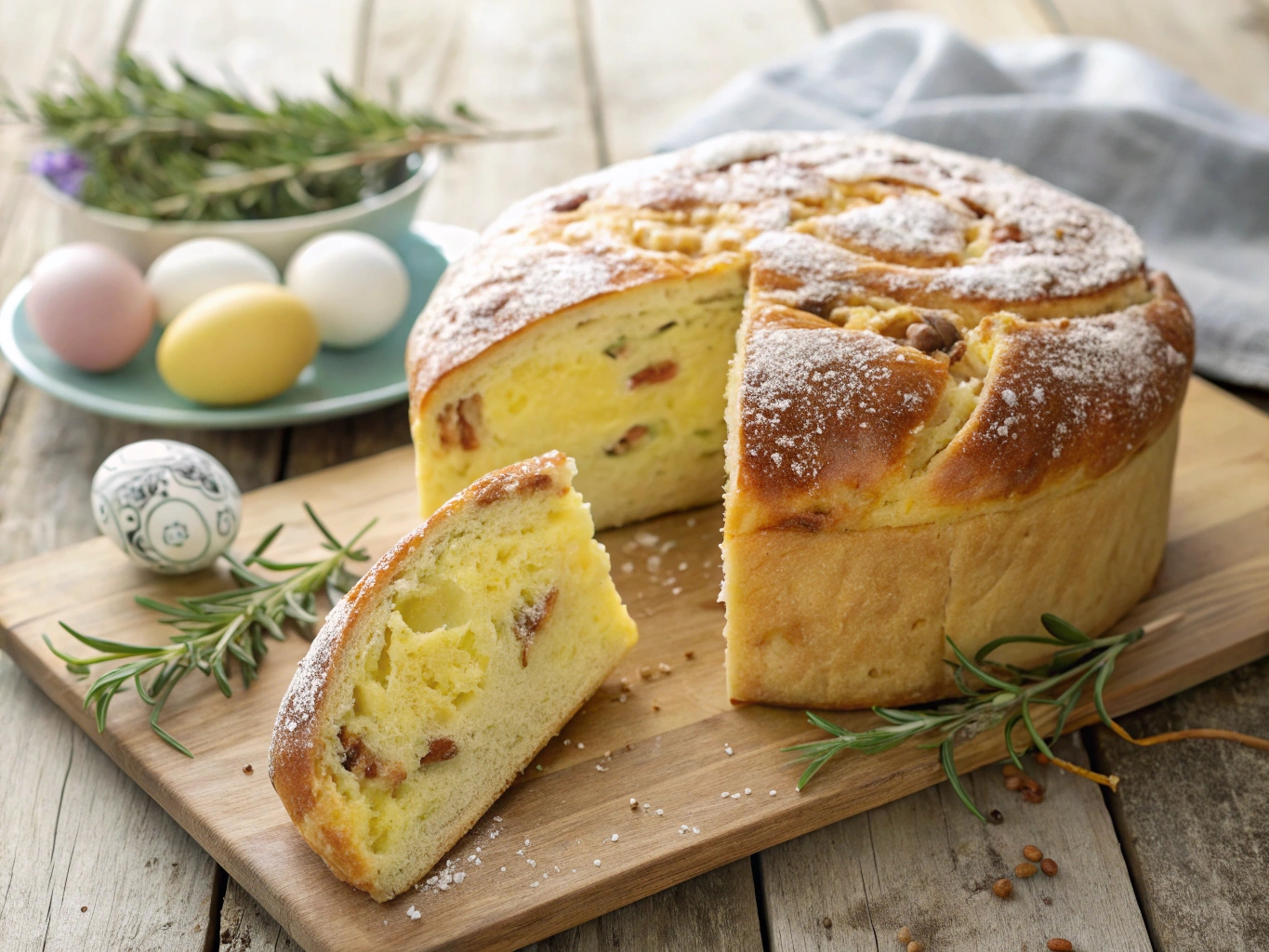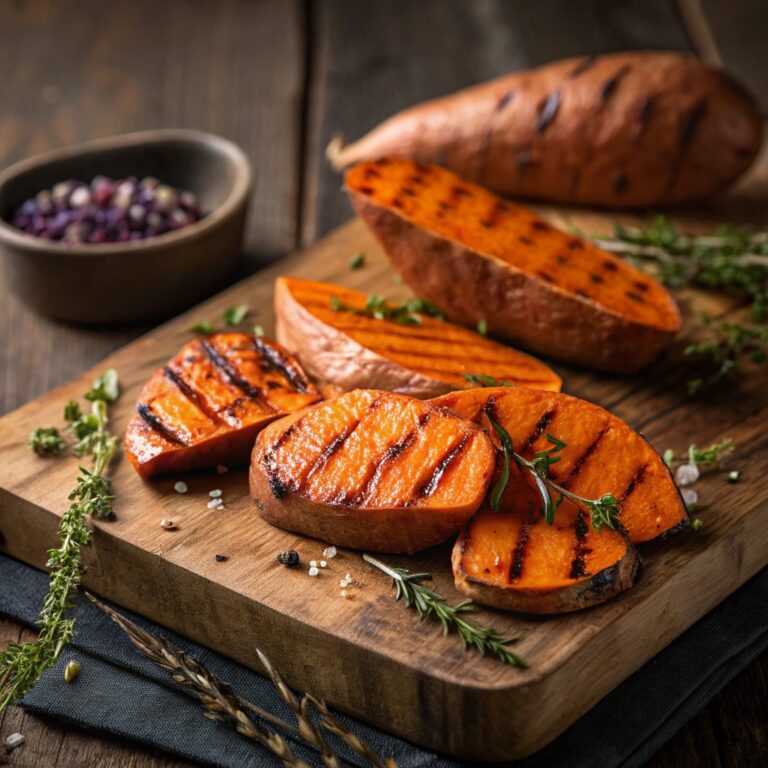Pizza di Pasqua: 5 Savory Italian Easter Breads Explained
Discover how to make traditional Italian Pizza di Pasqua, a delicious Easter food idea that will impress your family. Learn the secrets to this cheesy bread with our step-by-step recipe!
Introduction
Have you ever wondered what makes Italian Easter celebrations so special? The answer might just be on their tables! Pizza di Pasqua (literally “Easter Bread”) is a centerpiece of Italian holiday feasting that brings families together around a centuries-old tradition. This amazing cheese-infused bread rises tall and proud, symbolizing resurrection and new beginnings during the Easter season. Unlike the flat pizza you might be familiar with, this Easter food idea is actually a towering, dome-shaped bread with a texture similar to panettone but with a savory, cheesy profile that will have everyone asking for seconds. Today, I’m sharing my grandmother’s authentic recipe that takes just 30 minutes of active preparation time, though you’ll need patience for the rising. The results? Absolutely worth the wait!
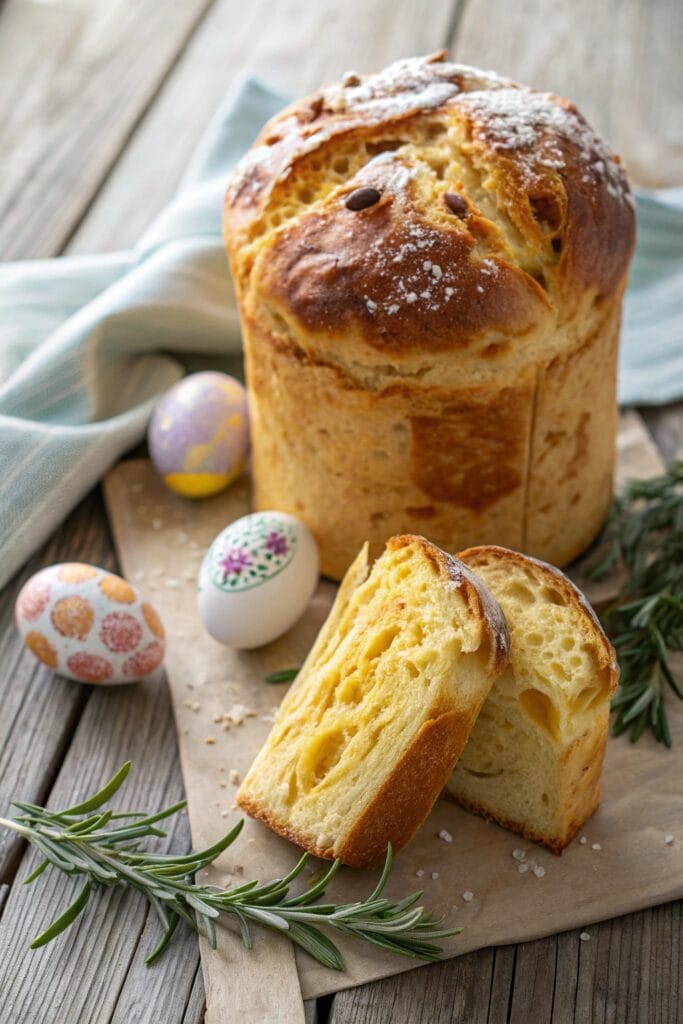
Table of Contents
1. Why Pizza di Pasqua Is Perfect For You
🔹 A showstopping Easter food centerpiece that impresses without complicated techniques 🔹 Rich in flavor but simple to prepare, making it perfect for bakers of all skill levels 🔹 Make-ahead friendly, allowing you to focus on other dishes during your holiday feast 🔹 Versatile enough to pair with Easter breakfast, brunch, or dinner spreads 🔹 Creates meaningful family traditions and conversations around your Easter table 🔹 Leftovers make incredible sandwiches or breakfast toast the next day
🔸 Ingredients List for 4 persons 👤👤👤👤
🔸 4 cups (500g) all-purpose flour 🔸 1 cup (250ml) whole milk, lukewarm 🔸 4 large eggs, room temperature 🔸 2½ teaspoons active dry yeast 🔸 ½ cup (115g) unsalted butter, softened 🔸 1½ cups (150g) grated Pecorino Romano cheese 🔸 1 cup (100g) grated Parmigiano-Reggiano 🔸 ½ cup (50g) grated provolone cheese 🔸 2 tablespoons granulated sugar 🔸 1½ teaspoons salt 🔸 1 teaspoon black pepper, freshly ground
🔸 Preparation Time and Servings
Total time: 4 hours 30 minutes
- Preparation: 30 minutes
- Rising time: 3 hours 30 minutes
- Baking: 30-40 minutes
This might seem like a lengthy process, but most of it is hands-off rising time. The active preparation is quite manageable, making this an impressive Easter food idea that doesn’t require professional baking skills. The lengthy rise is essential for developing that light, airy texture that Pizza di Pasqua is famous for.
4. Step-by-Step Instructions and Directions
Step 1: Activate the Yeast
In a small bowl, combine lukewarm milk with sugar and yeast. Stir gently and let sit for 5-10 minutes until foamy. Pro Tip: Milk should be around 110°F (43°C) – too hot will kill the yeast, too cold won’t activate it.
Step 2: Prepare the Dough Base
In a large mixing bowl, beat eggs until light and fluffy. Add the softened butter and continue beating until well incorporated. Fold in the activated yeast mixture.
Step 3: Add Dry Ingredients
Gradually add flour, salt, and black pepper to the wet ingredients, mixing until a shaggy dough forms. Pro Tip: Reserve ¼ cup of flour to adjust consistency if needed.
Step 4: Incorporate the Cheese
Fold in all three cheeses, reserving ¼ cup of Pecorino for topping. Mix until the cheese is evenly distributed throughout the dough.
Step 5: Knead and First Rise
Turn the dough onto a floured surface and knead for 5-7 minutes until smooth and elastic. Transfer to an oiled bowl, cover with plastic wrap, and let rise in a warm place for 2 hours, or until doubled in size.
Step 6: Shape and Second Rise
Punch down the dough and transfer to a buttered panettone pan or deep round cake pan (about 7-8 inches wide). Cover and let rise for another 1-1.5 hours until it reaches the top of the pan.
Step 7: Bake to Golden Perfection
Preheat oven to 350°F (175°C). Sprinkle the reserved Pecorino on top of the risen dough. Bake for 30-40 minutes until golden brown and a skewer inserted comes out clean. Pro Tip: If browning too quickly, cover loosely with foil.
Step 8: Cool and Serve
Allow the bread to cool in the pan for 10 minutes, then remove and cool completely on a wire rack before slicing. Serve at room temperature with your Easter feast.
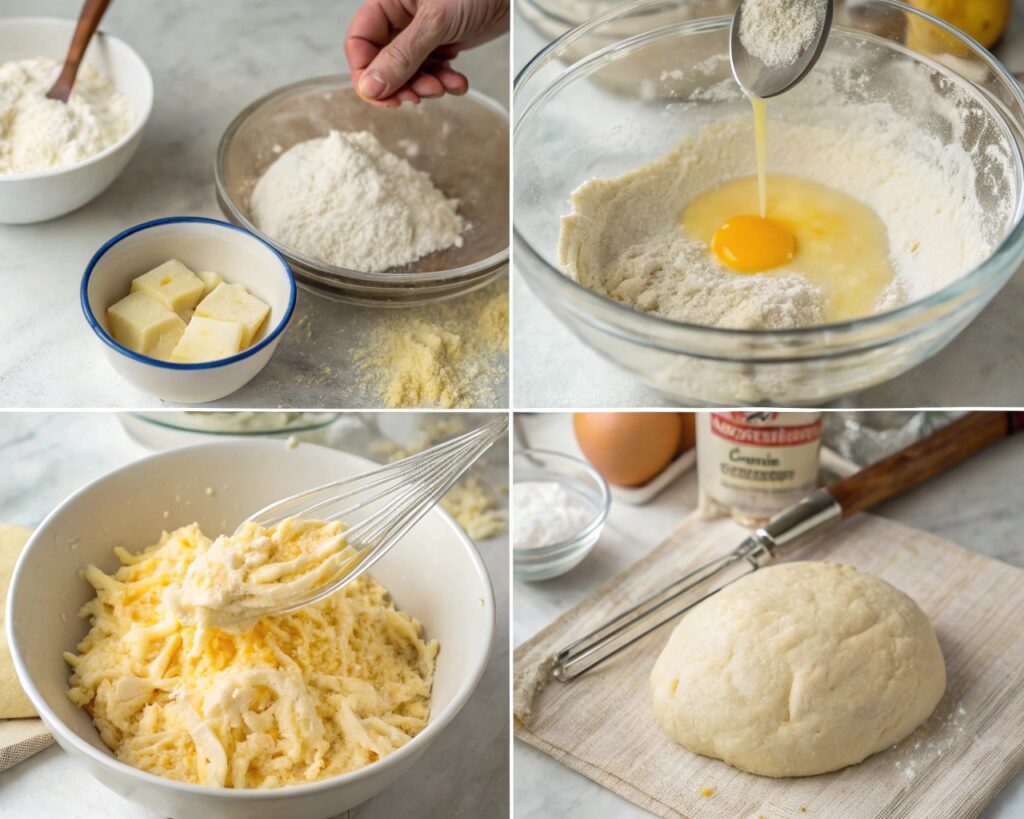
🔸 Special Equipment
- Panettone pan or 7-8 inch round cake pan (at least 4 inches deep)
- Stand mixer with dough hook (optional but helpful)
- Digital kitchen thermometer for checking milk temperature
- Plastic wrap and kitchen towels for covering during rising
- Wire cooling rack
🔸 Information and Food Benefits of the Substances Used in this Recipe
- Cheese Trio: The combination of aged Pecorino, Parmigiano-Reggiano, and provolone provides depth of flavor and different melting properties.
- Eggs: Contribute to the rich yellow color and help create the airy, brioche-like texture while adding protein.
- Whole Milk: The fat content enhances flavor and creates a tender crumb structure.
- Active Dry Yeast: Provides leavening through fermentation, developing complex flavors during the long rise.
- Black Pepper: A traditional addition that balances the richness of the cheese with subtle heat.
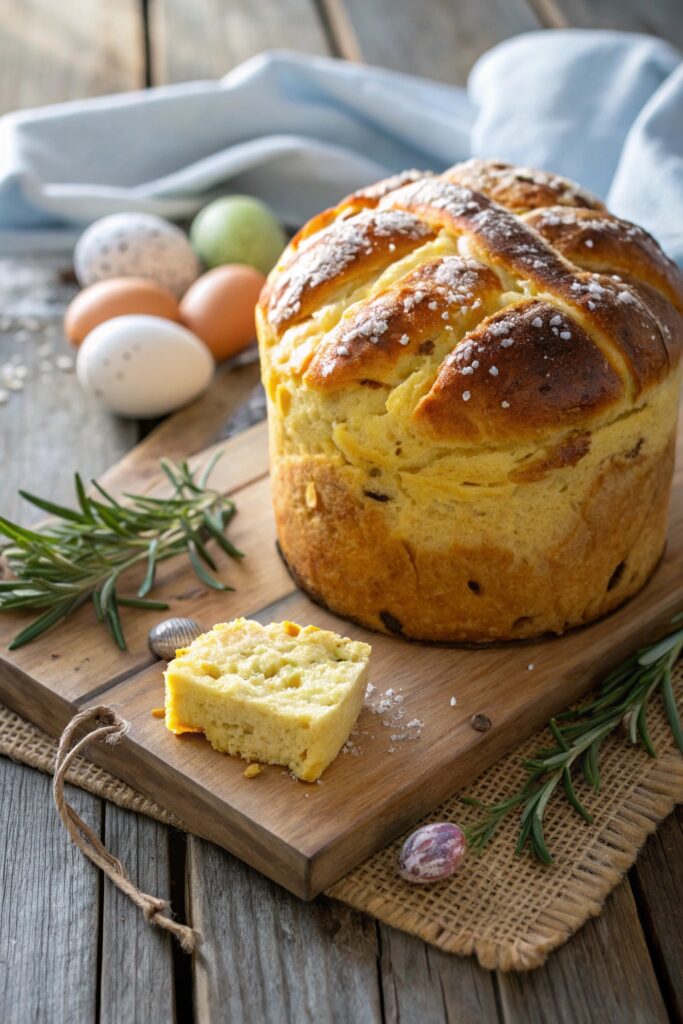
🔸 Calories per Person
| Nutrient | Amount per Serving |
|---|---|
| Calories | Approximately 570 kcal |
| Protein | 24g |
| Carbohydrates | 54g |
| Fat | 28g |
| Fiber | 2g |
| Calcium | 420mg |
🔸 Healthier Alternatives for the Recipe
- Substitute half the all-purpose flour with whole wheat flour for added fiber, though the texture will be slightly denser
- Reduce butter to ⅓ cup and add 2 tablespoons of olive oil for heart-healthier fats
- Use part-skim cheeses to reduce overall fat content by about 20%
- For lactose-sensitive individuals, use lactose-free milk and aged cheeses (which are naturally lower in lactose)
- For a lighter version, use 3 whole eggs plus 2 egg whites instead of 4 whole eggs
🔸 Serving Suggestions
This Pizza di Pasqua is incredibly versatile as an Easter food idea. Traditionally, Italians serve it as part of the Easter breakfast after morning church services, often alongside hard-boiled eggs, cured meats, and fresh fruit. You can also:
- Serve slices with a drizzle of high-quality honey for a sweet-savory experience
- Create an Easter brunch board with the bread as the centerpiece, surrounded by prosciutto, olives, and roasted red peppers
- Use leftovers for extraordinary ham sandwiches on Easter Monday
- Toast slices and top with ricotta and a sprinkle of herbs for a quick appetizer
- Serve alongside your Easter lamb or ham as an elevated dinner bread
🔸 Storage and Leftovers
Pizza di Pasqua stays fresh for 3-4 days when stored properly. Wrap cooled bread tightly in plastic wrap and store at room temperature for up to 2 days, or refrigerate for longer freshness. To revive its texture, wrap a slice in a damp paper towel and microwave for 10-15 seconds or toast lightly.
For longer storage, you can freeze individual slices or half loaves for up to 2 months. Thaw at room temperature and warm in a 300°F oven for 5-7 minutes to restore freshness.
🔸 Common Mistakes to Avoid
• Rushing the rise time – The lengthy fermentation develops flavor and proper texture • Using cold ingredients – Room temperature eggs and butter incorporate much better • Overworking the dough – Stop kneading when smooth and elastic to avoid tough bread • Opening the oven door too early – This can cause the bread to collapse • Cutting into the bread while hot – Let it cool properly to avoid a gummy texture • Using pre-shredded cheese – These contain anti-caking agents that can affect texture
🔸 FAQs
Can I make Pizza di Pasqua ahead of time? Yes! You can prepare the dough the day before and let it rise slowly in the refrigerator overnight. This actually enhances the flavor. Bring to room temperature before the final rise and baking.
What’s the difference between Pizza di Pasqua and regular bread? Pizza di Pasqua has a much higher proportion of eggs, cheese, and butter, creating a richer texture closer to brioche or panettone than everyday bread.
Can I add other flavors to my Pizza di Pasqua? Traditionally, it’s made with cheese and pepper, but some regions add dried fruits, herbs like rosemary, or even small pieces of salami. Feel free to experiment!
My bread didn’t rise as tall as expected. What went wrong? Check your yeast freshness, liquid temperature, and rising environment. The dough needs a warm, draft-free spot to rise properly.
Is Pizza di Pasqua only served at Easter? While traditionally an Easter food, there’s no reason not to enjoy this delicious bread year-round for special occasions.
Can I make mini versions instead of one large bread? Absolutely! Divide the dough among buttered muffin tins for individual servings, reducing the baking time to about 15-18 minutes.
🔸 Conclusion
Pizza di Pasqua isn’t just bread—it’s a celebration of spring, family, and tradition. This towering, cheese-infused loaf has graced Italian Easter tables for generations, and now it can become part of your holiday traditions too. The combination of three distinctive cheeses creates a depth of flavor that pairs beautifully with other Easter foods, making it versatile enough for breakfast, brunch, or dinner. While it requires patience during the rising process, the actual hands-on time is minimal—and the result is a showstopping centerpiece that will have everyone at your table impressed with your baking skills. Whether you’re looking to connect with Italian heritage or simply want to try a new Easter food idea that goes beyond the ordinary, this Pizza di Pasqua recipe delivers both spectacular flavor and meaningful tradition to your celebration.
Contact Us
Contact us at [email protected], and we’ll get back to you as soon as possible.
Share your experience with us
good for a nice dinner
nice

